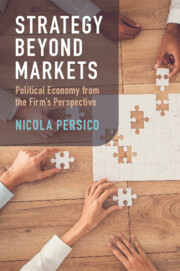143 results
Seeking friends and influencers: business and labor groups lobbying in the Chilean congress
-
- Journal:
- Business and Politics , First View
- Published online by Cambridge University Press:
- 21 October 2024, pp. 1-19
-
- Article
-
- You have access
- HTML
- Export citation
Why business adoption of quantum and AI technology must be ethical
-
- Journal:
- Research Directions: Quantum Technologies / Volume 2 / 2024
- Published online by Cambridge University Press:
- 30 September 2024, e4
-
- Article
-
- You have access
- Open access
- HTML
- Export citation

Peopling for Profit in Imperial Brazil
- Directed Migrations and the Business of Nineteenth-Century Colonization
-
- Published online:
- 26 September 2024
- Print publication:
- 13 June 2024
China in Africa: companies as enablers and beneficiaries? An empirical evaluation of state-business relations in the Forum on China-Africa Cooperation
-
- Journal:
- Business and Politics , First View
- Published online by Cambridge University Press:
- 18 September 2024, pp. 1-25
-
- Article
-
- You have access
- HTML
- Export citation
6 - Fighting “Woke Capitalism”: The Republican Rebellion against Corporate America
-
- Book:
- Polarized by Degrees
- Published online:
- 05 September 2024
- Print publication:
- 05 September 2024, pp 204-240
-
- Chapter
- Export citation
2 - Loss of Lives, Livelihoods and Love
- from Part I - Apocalypse No!
-
- Book:
- The Peace Formula
- Published online:
- 31 August 2024
- Print publication:
- 15 August 2024, pp 20-30
-
- Chapter
- Export citation
Part IV - Building a Career
-
- Book:
- The Cambridge Companion to Composition
- Published online:
- 25 May 2024
- Print publication:
- 30 May 2024, pp 285-318
-
- Chapter
- Export citation
7 - Sexuality and Consumerism in the Modern World: The Business of Pleasure
-
-
- Book:
- The Cambridge World History of Sexualities
- Published online:
- 26 April 2024
- Print publication:
- 16 May 2024, pp 136-158
-
- Chapter
- Export citation
2 - Cleaning Our Messes
- from Part I - Geographies of Environmental Violence
-
-
- Book:
- Exploring Environmental Violence
- Published online:
- 06 June 2024
- Print publication:
- 09 May 2024, pp 50-62
-
- Chapter
-
- You have access
- Open access
- HTML
- Export citation
Realtors Interpret History: The Intellectual Origins of Early National Real Estate Organizing
-
- Journal:
- The Journal of the Gilded Age and Progressive Era / Volume 23 / Issue 2 / April 2024
- Published online by Cambridge University Press:
- 17 May 2024, pp. 190-212
- Print publication:
- April 2024
-
- Article
-
- You have access
- HTML
- Export citation
The emergence of financial capital in the health insurance business in Europe: The case of Spain in the last fifty years
-
- Journal:
- Revista de Historia Economica - Journal of Iberian and Latin American Economic History / Volume 42 / Issue 2 / September 2024
- Published online by Cambridge University Press:
- 05 March 2024, pp. 217-242
- Print publication:
- September 2024
-
- Article
-
- You have access
- Open access
- HTML
- Export citation
4 - The Merchant House
- from Part II - The Lineaments of Racial Capitalism
-
- Book:
- Lucky Valley
- Published online:
- 11 January 2024
- Print publication:
- 22 February 2024, pp 156-201
-
- Chapter
- Export citation
6 - Competitive Coparcenary: Vakhatchand Jhaveri and Brokering Politics, 1730–1818
-
- Book:
- Bankrolling Empire
- Published online:
- 16 November 2023
- Print publication:
- 30 November 2023, pp 223-260
-
- Chapter
- Export citation
10 - From Kyoto to Paris
- from Section IV - Responsibility: Corporate Political Responsibility and Climate
-
-
- Book:
- Corporate Political Responsibility
- Published online:
- 16 November 2023
- Print publication:
- 30 November 2023, pp 278-309
-
- Chapter
- Export citation

Strategy Beyond Markets
- Political Economy from the Firm's Perspective
-
- Published online:
- 02 November 2023
- Print publication:
- 16 November 2023
Introduction
-
- Book:
- Big Business and the Crisis of German Democracy
- Published online:
- 19 October 2023
- Print publication:
- 02 November 2023, pp 1-7
-
- Chapter
-
- You have access
- Open access
- HTML
- Export citation
‘When There Is a Ban, There Is a Way’: Everyday Gambling and the Nigerian Political Economy, 1977–83
-
- Journal:
- The Journal of African History / Volume 64 / Issue 3 / November 2023
- Published online by Cambridge University Press:
- 12 December 2023, pp. 351-367
- Print publication:
- November 2023
-
- Article
-
- You have access
- Open access
- HTML
- Export citation
Chapter 8 - Cinema and Theatre in the Great War
- from Part II - Theatre during the War
-
-
- Book:
- The Cambridge Companion to British Theatre of the First World War
- Published online:
- 19 October 2023
- Print publication:
- 19 October 2023, pp 144-159
-
- Chapter
- Export citation
11 - The True Cost of Opioid Addiction Treatment
- from Part III - The Treatment Plan
-
- Book:
- The Opioid Epidemic
- Published online:
- 07 October 2023
- Print publication:
- 12 October 2023, pp 136-143
-
- Chapter
- Export citation
Corporate Social Irresponsibility, an Elastic Wall, and a Fragile State: Sign of Hope’s Unfinished Quest to Mitigate Human Rights Violations in South Sudan
-
- Journal:
- Business and Human Rights Journal / Volume 8 / Issue 3 / October 2023
- Published online by Cambridge University Press:
- 06 October 2023, pp. 454-460
-
- Article
-
- You have access
- Open access
- HTML
- Export citation

